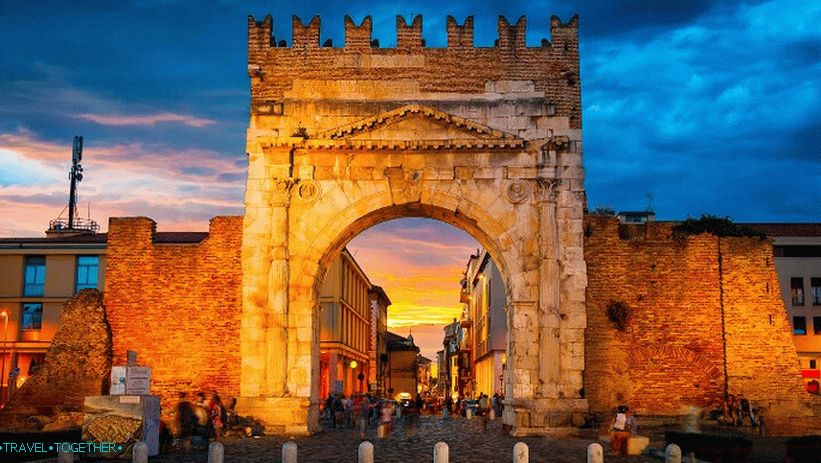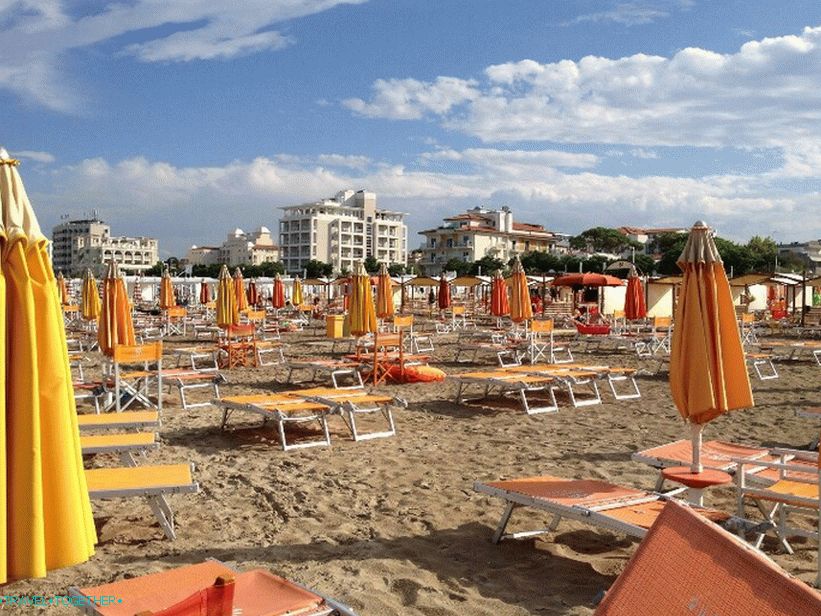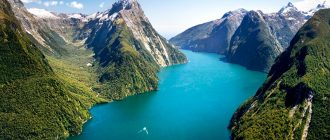Rimini (Italy) – the most detailed information about the city with photos. The main attractions of Rimini with a description, guides and cards.
Contents
City of Rimini (Italy)
Rimini – a city on the Adriatic coast of Italy in the region Emilia-Romagna, one of the largest Italian resorts. Is famous its riviera and as the birthplace of the outstanding director Federico Fellini. Rimini is a long white sandy beach that stretches. north and south of the port, lively nightlife, gorgeous cultural and historical heritage. Tens of thousands of tourists flock here to swim in the Adriatic Sea, sunbathe in the sun, have fun in clubs and bars, see the remains of the Roman of the past.
The ancient settlement of the place of Rimini – Ariminum, grew where Two important Roman roads intersected – Via Aemilia and Via Flaminia. Much later, the city first became lively. port, and then became a famous resort. Despite the bombing World War II, much of the historical heritage remained untouched.
 Rimini, night
Rimini, night
- Geography and climate
- Practical information
- Story
- How to get there
- Shopping and shopping
- Food and drink
- sights
- Video
- Maps and guides
- Comments and reviews
Geography and climate
Rimini is located on the east coast of Italy between The Adriatic Sea and the hills of the Apennine Foothills in the southern part the valleys of the Po. Near the rivers flow Marekkya and Auza. Sandy beaches stretched almost 15 km. Climate – humid subtropical with significant maritime influence. Summer is hot and sunny, winter is warm
 Rimini beaches
Rimini beaches
Practical information
- The population is 146.6 thousand people.
- The area is 134 square kilometers.
- The language is Italian.
- Currency – Euro.
- Visa – Schengen.
- Time – Central European UTC +1, in summer +2.
- High season – July and August. In June and September holidaymakers significantly less.
Story
The first Etruscans began to settle on the site of modern Rimini. Their The settlement dates from the first millennium BC. Later on these the lands came the Gauls and the Greeks. In the 3rd century BC, the Romans founded in the mouth of the river Marekkya its stronghold – Ariminum. The city has become important transportation hub. In this place several important converged Roman roads connecting the north and south of the Roman Empire. Roman the past has left us a unique historical and cultural heritage.
The decline of Rimini (like the whole mighty empire) coincided with the barbaric invasions. In the 5th century, the settlement was captured by the Goths, who in the middle of the 6th century ousted the Byzantines. In the first half of the 8th century, these lands occupied by the Lombards, which after a while changed francs. The latter handed them over to the Pope. In the 10th century Rimini was part of the Holy Roman Empire.
 Rimini Streets
Rimini Streets
In the 13th century, the Malatesta family came to power, which some became the sole owner of the city. This family rules in Rimini until 1528. After that, the city was a zone of papal influence. At the end of the 18th century, Rimini was occupied by French troops. In 1860 the city became part of the united Italy. During the Second World War, Rimini was partially destroyed. With this, most of it Attractions practically not affected.
How to get there
Rimini has its own airport, which offers a fairly large number of areas: Amsterdam, Berlin, Prague, Moscow, Krasnodar, etc.
You can also get to Rimini by train from Bologna, Milan, Venice, Rome. From Rome and back there are buses FlixBus. City has excellent road toll connections with Milan, Florence and Rome.
Shopping and shopping
Rimini, neighboring Riccione and the Republic of San Marino are many fashion brand boutiques, stores “Made in Italy” and Outlets with discounts. Here are the famous shoe factory: Casadei, Giuseppe Zanotti, Baldinini, Sergio Rossi, Gianvito Rossi. A large number of shops located in the historic center. cities: Augusta Boulevard, Garibaldi Street, Tre Martini Square. A great place for shopping is Ceccarini Boulevard (Ceccarini) in Riccione and San Marino.
 Rimini night
Rimini night
Food and drink
Rimini is an excellent Italian cuisine from inexpensive pizzerias to elite restaurants. Traditional dishes here are pizza, various pasta, lasagna, cheese. From traditional products worth buy olive oil, soft Squacquerone cheese, fossa cheese, wine.
From myself I want to add that it is in Rimini, in an inconspicuous cafe on the shore of the Adriatic Sea, we tried the most delicious lasagna in Italy.
sights
Rimini is not only a famous youth resort, but also many attractions, some of which were built in the period of antiquity.
 Arch of Augustus
Arch of Augustus
The Arch of Augustus is one of the main attractions of Rimini, The oldest Roman triumphal arch in Northern Italy, built in 27 BC to commemorate the construction of the ancient road Flaminia. Located on the southern tip of Corso di Augusto, main street of the city. The arch is unusual in that it was not adapted to the gate, thus symbolizing the newly achieved peace after a long period of wars. Battlement at the top – medieval addition replacing the crown which is probably was crowned with a statue of Augustus.
 Beaches
Beaches
Along the Adriatic coast to the northeast of the old cities stretch the famous beaches of Rimini with hotels, sports grounds and rows of multi-colored beach umbrellas with deck chairs. Beach places are rented. Near the port rises huge ferris wheel.
Let’s be honest: the sea in Rimini is not the most beautiful. In croatia for example, the Adriatic Sea is much better. But the beach Infrastructure above all praise!
 Tempio Malatestiano
Tempio Malatestiano
Tempio Malatestiano – a structure built in the style of the early Renaissance as the tomb of the Malatesta family on the site of a small medieval church. Construction dates back to the 15th century. Facade was designed by Leon Battista Alberti in the Roman tradition, which drew inspiration from the arch of Augustus. The interior is decorated with frescoes by Piero della Francesco and the only work of Giotto in Rimini. Marble the facings of the six guard chapels are so finely carved that they seem almost monochromatic paintings.
 Ponte tiberio
Ponte tiberio
Ponte Tiberio – an ancient Roman bridge over the Marecchia River, built in the year 20 AD.
 Borgo San Giuliano
Borgo San Giuliano
San Giuliano is a picturesque area of Rimini right behind the Tiberius Bridge with small brightly painted houses and narrow charming the streets. Here are the old fishing districts.
 Piazza Cavour
Piazza Cavour
Piazza Cavour is a charming square in Rimini. City center, starting in the Middle Ages. Busy place with weekly markets Wednesday and Saturday. In the cafe until 11 o’clock you can enjoy fragrant cappuccino
What else to see and visit in Rimini and its surroundings:
- City Museum in a former Jesuit monastery – Roman collections mosaics, sculptures, coins, ceramics, which is an ancient surgical and pharmaceutical equipment. The highlight of the collection are surgical equipment of an ancient doctor whose home was excavated in Piazza Ferrari square.
- Italy in miniature – more than 200 most famous sights of Italy, reproduced in scale (Via Popilia 239, Viserba di Rimini).
- San Marino is a dwarf state and the oldest republic in the world. We recommend to see the historic center on the mountain Monte Titano.
- Riccione is a small town southeast of Rimini with excellent beaches.
- Fiabilandia is a popular amusement park.
- The old fish market is one of the nightlife centers of Rimini.
- Marina Centro – the center of the embankment.
- The harbor (Marina di Rimini) is a great place to walks.
Video
Maps and guides
City Map Tourist Map of Rimini Travel Guide in English language






